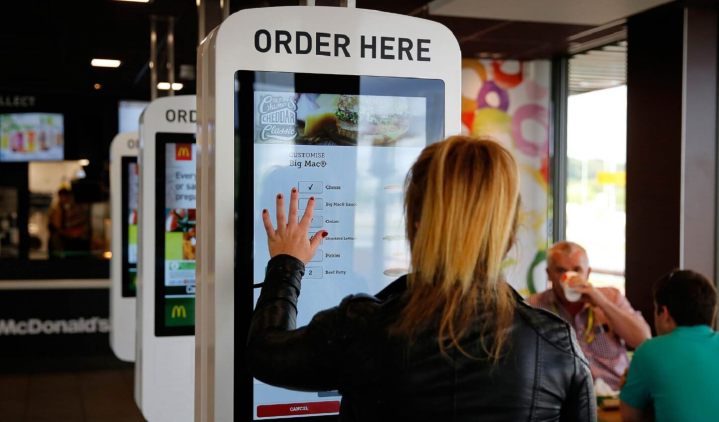A-RETAIL. RETAIL AUTOMATION. What does it mean? Which are the causes behind it? What the consequences for the consumer and for the retailer?
Let’s start from the beginning.
The term A-RETAIL, indicates Automated Retail or RETAIL AUTOMATION and describes the process of using technology to automate or semi-automate the retail experience. Meaning this: self-check kiosks, mobile app to pay instore or getting rid of checkout altogether.
It is no news that successful retailing today comes down to obsessing about customer experience. Customer experience should be pleasant, seamless between online and offline, painless, quick and personalized.
To simplify: ever tried to go shopping to Zara on a Black Friday? Endless queues, overcrowded stores, waiting for hours, stressed out sale assistants? Well, the opposite.
Researches show that the purchase phase is the most stressful and painful one. Waiting in long lines at checkout is one of the reasons why shoppers are turning to online shopping: it is no wonder the first thing retailers are innovating is the phase of the purchase. They hope to increase visits and sales instore and contain the race to online shopping.
Today, in 2018, we can find several examples of big companies and start-ups jumping on the boat of a (partially) automated shopping experience.

The shed-water event of 2018 has been the opening of the first Amazon Go store in Seattle, at the beginning of year. After more than 2 years of tests the ecommerce giant opened its first store almost completely automated, where the customer can just walk out with whatever items they choose and have them charged to their Amazon Prime account.
To be able to shop in the store customers must download the Amazon Go app. In the store technologies as computer vision, sensors, cameras and learning algorithms are used to automate the purchase process allowing people to check out without passing from the cashier. Weight sensors on shelves and cameras on the ceiling detect when the customer takes a product and add it on the person’s virtual cart.
Amazon is definitely one of the main characters in the retail and etail industry, but it is not the first in automating part(s) of the shopping process.
Founded in 2016, the Chinese company BingoBox, counts today around 300 automated shops, in almost 30 cities around the country. The process of automation is not as high-tech as the Amazon Go’s one: all the items are labelled with RFID tag, the customers at the exit must scan the products in a standard self-checkout machine, and then pay using WeChat.
Other than these Chinese realities today dozens of other start-ups are emerging worldwide, launching similar concepts and applications.


Food and grocery stores are where the highest number of automated processes examples are visible. Let’s think about the kiosks in McDonalds, where costumers are able to order and pay using a screen and pick up the meal when ready; or the self-checkout cashier at almost every franchise grocery store today.

How does this trend translate into fashion? The expectations of someone buying cereals and milk are different from the service a person looking for an expensive dress expects. How can automation affect the customer experience in fashion? Can we still expect to have a level of human interaction?
In 2018 Zara, Mango and other big actors started automating part of the instore experience, creating self-checkout kiosks and/or giving the possibility to pay with the mobile phone via App. The customer only has to walk in, pick up the clothes she/he likes, self-checks out and exits the store. No human interaction needed.
Same thing happening in the NYC store of Rebecca Minkoff, where, since December 2016 customers have the possibility to self check out using ipads instore, with the same technology employed by the Chinese BingoBox.
Let’s add to all these premises the customers we are talking to: Millennials.
Among Millennials there is a growing desire for control of every aspect of their shopping, payment included: “Long gone are the days where you needed to depend fully on a sales assistant to request new sizes or to ring you up,” said Uri Minkoff, CEO at Rebecca Minkoff.

Saving time, avoid stressful situations and control over the shopping processes: let sum a certain “obsession” for privacy and anonymity and the introduction of automation instore seems almost inevitable.
But there are wider implications of automation beyond speed and convenience: a definitely lower labour costs and increased efficiency just to mention a few.
As reported by McKinsey Global Institute, “tasks that are likely to be automated by 2055 […], currently make the 51% of work tasks in US, accounting for almost 2.7$.” To put that in perspective: About five million people are employed as retail sales workers in the United States alone, according to the Bureau of Labor Statistics. The Times also noted that venture capitalists have put $100 million into retail automation startups in the United States each of the past two years, based on research from financial data firm Pitchbook.
Technologies may eliminate millions of jobs and deliver better quality in a more efficient and reliable way than humans. Among the industries most likely to be affected we find manufacturing and retail.
Self checkout and automated payments instore are probably going to divide the mass fashion from the premium and luxury fashion, since they make more sense for the former. But, one way or another, appears clear that a-commerce, with automation regarding almost every part of the production chain, is going to have a deep impact on the fashion and retail industry, changing the way consumers behave and their expectations from retailers.
Fashion appears to be destined to be reshaped by automation, but we, as customers and retailers, are still in time to understand and determine how.
Continue reading “A-Retail. The automated future of retail, from fashion to grocery stores.”




